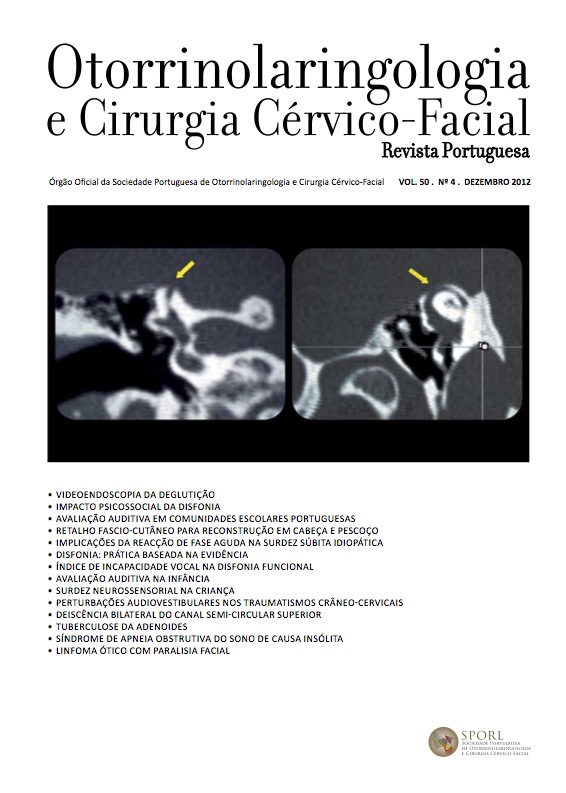Doentes Covid-19 traqueotomizados num hospital terciário: resultados a longo prazo na Voz, Deglutição e Via Aérea
DOI:
https://doi.org/10.34631/sporl.1030Palavras-chave:
COVID-19, Traqueotomia, Voz, Deglutição, Ventilação mecânica invasiva, ComplicaçõesResumo
A COVID-19 resultou num aumento de doentes traqueotomizados sob ventilação mecânica prolongada, cujas consequências na voz, deglutição e via aérea alta são pouco conhecidas, pelo que foi objetivo deste trabalho estudá-las. Foram considerados 37 doentes com COVID-19, internados numa Unidade de Cuidados Intensivos, traqueotomizados e descanulados entre março de 2020 e novembro de 2021. Foram incluídos no estudo 14 doentes, todos eles submetidos a entrevista com aplicação de inquéritos e 8 sujeitos também a endoscopia flexível. A média de idades foi de 49 anos e o racio masculino:feminino de 11:3. O tempo médio de entubação até à traqueotomia foi de 24 dias e até à descanulação de 51. 29% relataram alterações da deglutição, 14% da voz e 29% sintomas indicativos de refluxo faringolaríngeo. 62% das endoscopias apresentavam alterações. Os resultados preliminares mostram elevada incidência de lesões laríngeas, mas são necessários estudos a longo prazo, incluindo em doentes com COVID-19 não traqueotomizados.
Downloads
Referências
- Guan WJ, Ni ZY, Hu Y, Liang WH, Ou CQ, He JX. et al Clinical characteristics of coronavirus disease 2019 in China. N Engl J Med. 2020 Apr 30;382(18):1708-1720. doi: 10.1056/NEJMoa2002032.
- Wu Z, McGoogan JM. Characteristics of and important lessons from the coronavirus disease 2019 (COVID-19) outbreak in China: summary of a report of 72314 cases from the Chinese Center for Disease Control and Prevention. JAMA. 2020 Apr 7;323(13):1239-1242. doi: 10.1001/jama.2020.2648.
- Piazza C, Filauro M, Dikkers FG, Nouraei SAR, Sandu K, Sittel C. et al. Long‑term intubation and high rate of tracheostomy in COVID‑19 patients might determine an unprecedented increase of airway stenoses: a call to action from the European Laryngological Society. Eur Arch Otorhinolaryngol. 2021 Jan;278(1):1-7. doi: 10.1007/s00405-020-06112-6.
- Tay JK, Khoo ML, Loh WS. Surgical considerations for tracheostomy during the COVID-19 pandemic: lessons learned from the severe acute respiratory syndrome outbreak. JAMA Otolaryngol Head Neck Surg. 2020 Jun 1;146(6):517-518. doi: 10.1001/jamaoto.2020.0764.
- Freeman BD, Morris PE. Tracheostomy practice in adults with acute respiratory failure. Crit Care Med. 2012 Oct;40(10):2890-6. doi: 10.1097/CCM.0b013e31825bc948.
- Siempos II, Ntaidou TK, Filippidis FT, Choi AMK. Efect of early versus late or no tracheostomy on mortality and pneumonia of critically ill patients receiving mechanical ventilation: a systematic review and meta-analysis. Lancet Respir Med. 2015 Feb;3(2):150-158. doi: 10.1016/S2213-2600(15)00007-7.
- Rouhani MJ, Clunie G, Thong G, Lovell L, Roe J, Ashcroft M. et al. A prospective study of voice, swallow, and airway outcomes following tracheostomy for COVID-19. Laryngoscope. 2021 Jun;131(6):E1918-E1925. doi: 10.1002/lary.29346.
- COVIDTrach collaborative. COVIDTrach; the outcomes of mechanically ventilated COVID-19 patients undergoing tracheostomy in the UK: Interim Report. Br J Surg. 2020 Nov;107(12):e583-e584. doi: 10.1002/bjs.12020.
- Piazza C, Filauro M, Dikkers FG, Nouraei SAR, Sandu K, Sittel C. et al. Long-term intubation and high rate of tracheostomy in COVID-19 patients might determine an unprecedented increase of airway stenoses: a call to action from the European laryngological society. Eur Arch Otorhinolaryngol. 2021 Jan;278(1):1-7. doi: 10.1007/s00405-020-06112-6.
- Brodsky MB, Levy MJ, Jedlanek E, Pandian V, Blackford B, Price C. et al. Laryngeal injury and upper airway symptoms after oral endotracheal intubation with mechanical ventilation during critical care: a systematic review. Crit Care Med. 2018 Dec;46(12):2010-2017. doi: 10.1097/CCM.0000000000003368.
- Rosen CA, Lee AS, Osborne J, Zullo T, Murry T. Development and validation of the voice handicap Index-10. Laryngoscope. 2004 Sep;114(9):1549-56. doi: 10.1097/00005537-200409000-00009.
- Azevedo SR, Santos M, Sousa F, Freitas S, Coutinho MB, Sousa CAE. et al. Validation of the portuguese version of the voice handicap Index-10. J Voice. 2020 Nov 20;S0892-1997(20)30410-0. doi: 10.1016/j.jvoice.2020.10.019.
- Belafsky PC, Postma GN, Koufman JA. Validity and reliability of the reflux symptom index (RSI). J Voice. 2002 Jun;16(2):274-7. doi: 10.1016/s0892-1997(02)00097-8.
- Almeida AG, Saliture TB, da Silva AS, Eckley CA. Translation and cultural adaptation of the reflux finding score into brazilian portuguese. Braz J Otorhinolaryngol. Jan-Feb 2013;79(1):47-53. doi: 10.5935/1808-8694.20130009.
- Belafsky PC, Mouadeb DA, Rees CJ, Pryor JC, Postma GN, Allen J. et al. Validity and reliability of the eating assessment tool (EAT-10). Ann Otol Rhinol Laryngol. 2008 Dec;117(12):919-24. doi: 10.1177/000348940811701210.
- Queirós A, Moreira S, Silva A, Costa R, Lains J. Contributo para a adaptação e validação da eat assessment tool (EAT-10) e da functional oral intake scale (FOIS). Revista da Sociedade Portuguesa de Medicina Física e de Reabilitação [Internet] 2013; 24(2):25-30. Available from: http://dx.doi.org/10.25759/spmfr.108.
- Crary MA, Mann GD, Groher ME. Initial psychometric assessment of a functional oral intake scale for dysphagia in stroke patients. Arch Phys Med Rehabil. 2005 Aug;86(8):1516-20. doi: 10.1016/j.apmr.2004.11.049.
- Patterson JM, Hildreth A, McColl E, Carding PN, Hamilton D, Wilson JA. The clinical application of the 100 mL water swallow test in head and neck cancer. Oral Oncol. 2011 Mar;47(3):180-4. doi: 10.1016/j.oraloncology.2010.11.020
- Carfì A, Bernabei R, Landi F; Gemelli Against COVID-19 Post-Acute Care Study Group. Persistent symptoms in patients after acute COVID-19. JAMA. 2020 Aug 11;324(6):603-605. doi: 10.1001/jama.2020.12603.
- Jiang G, Cai Y, Yi X, Li Y, Lin Y, Li Q. et al. The impact of laryngopharyngeal reflux disease on 95 hospitalized patients with COVID-19 in Wuhan, China: a retrospective study. Med Virol. 2020 Oct;92(10):2124-2129. doi: 10.1002/jmv.25998.
- Lorenz RR. Adult laryngotracheal stenosis: etiology and surgical management. Curr Opin Otolaryngol Head Neck Surg. 2003 Dec;11(6):467-72. doi: 10.1097/00020840-200312000-00011.
- Pedersen A, Wilson J, McColl E, Carding P, Patterson J. Swallowing outcome measures in head and neck cancer - how do they compare? Oral Oncol. 2016 Jan;52:104-8. doi: 10.1016/j.oraloncology.2015.10.015.
- Wu MC, Chang YC, Wang TG, Lin LC. Evaluating swallowing dysfunction using a 100-ml water swallowing test. Dysphagia. 2004 Winter;19(1):43-7. doi: 10.1007/s00455-003-0030-x.
Downloads
Publicado
Como Citar
Edição
Secção
Licença
Direitos de Autor (c) 2022 Os autores mantêm os direitos de autor deste artigo.

Este trabalho encontra-se publicado com a Licença Internacional Creative Commons Atribuição-CompartilhaIgual 4.0.






